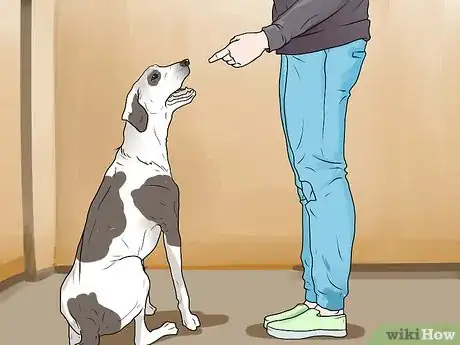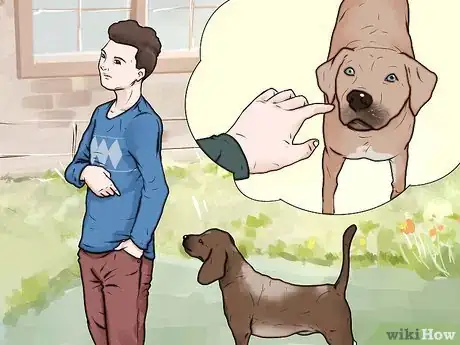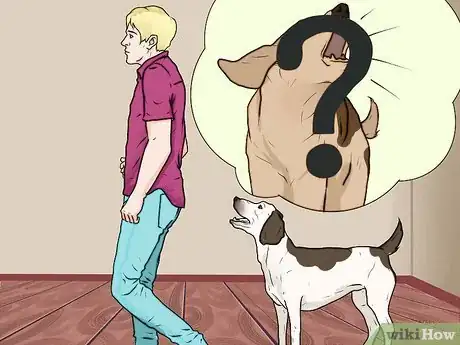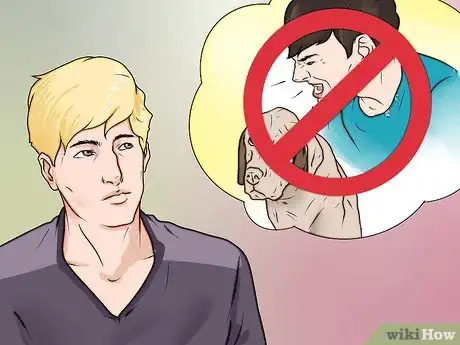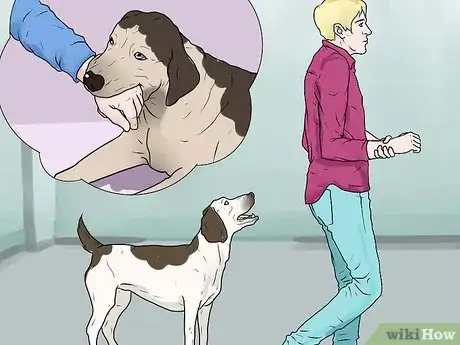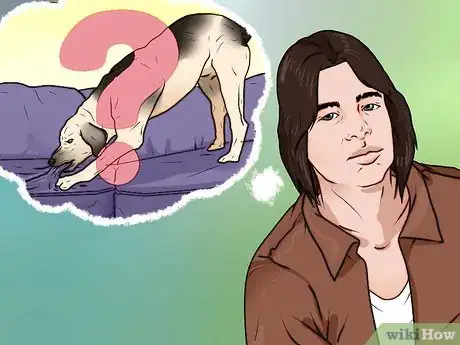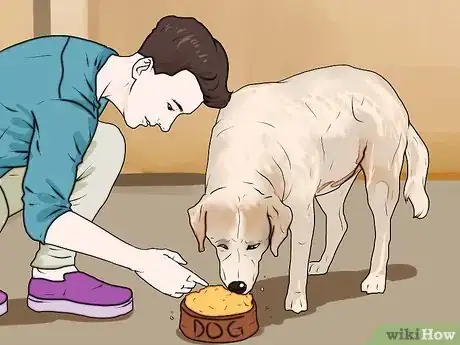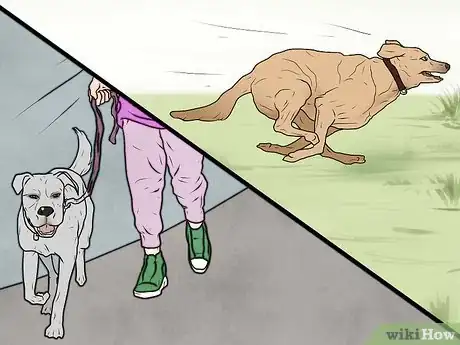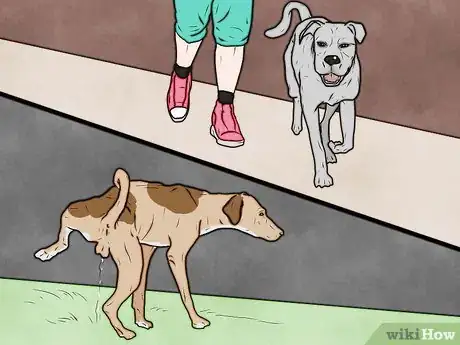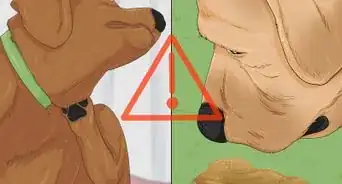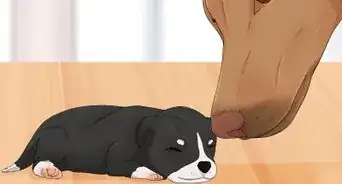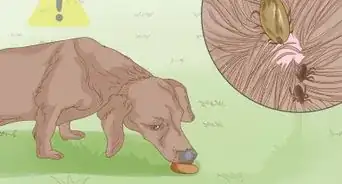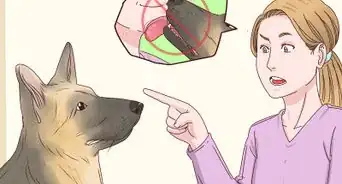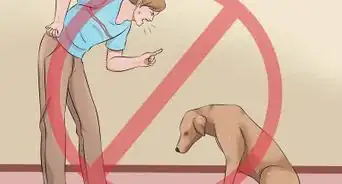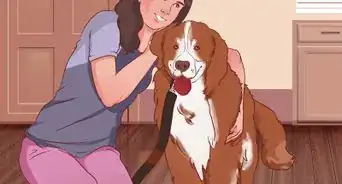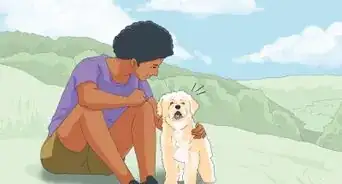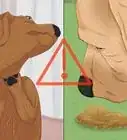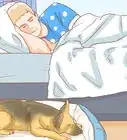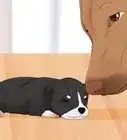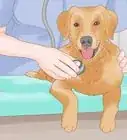This article was co-authored by David Levin. David Levin is the Owner of Citizen Hound, a professional dog walking business based in the San Francisco Bay Area. With over 9 years of professional dog walking and training experience, David's business has been voted the "Best Dog Walker SF" by Beast of the Bay for 2019, 2018, and 2017. Citizen Hound has also been ranked #1 Dog Walker by the SF Examiner and A-List in 2017, 2016, 2015. Citizen Hound prides themselves on their customer service, care, skill, and reputation.
There are 10 references cited in this article, which can be found at the bottom of the page.
This article has been viewed 293,032 times.
When your dog acts out with bad behavior, you may want to discipline them. This simply means you want to let them know that the behavior is unacceptable. Instead of shouting or hitting your dog, you'll want to use more effective punishments, like ignoring them or withdrawing your attention. Since dogs respond to positive reinforcement, your dog will quickly learn what behaviors to avoid.
Steps
Responding to Bad Behavior
-
1Correct your dog's behavior. If your dog misbehaves, give them a cue or sign that they've made the wrong decision. You might say, "think again," or a similar phrase in a cheery, but corrective tone of voice. The tone should suggest, "Are you sure you want to do that?" Your dog will recognize your tone as much as the words.[1]
- Remember that your dog is not maliciously trying to disobey you. When your dog does something you don't want them to do, you need to let them know not to repeat this behavior in the future.[2]
- React quickly to bad behaviors you want to stop. Associations between a behavior and a consequence must be very close together in time for your dog to easily understand the relationship between the two.[3]
-
2Remove your attention. If the dog continues to do the wrong thing, turn your back or leave the room so that your withdraw attention.[4] Dogs are sociable animals and want to be at the center of things. Being left out or ignored makes them reconsider their actions. If you catch bad behavior early, you can stop it before it's ingrained.[5]
- For example, if you're teaching your dog a command and they refuse, say, "think again," and turn your back. Your dog should realize that they've done the wrong thing. Turn back around and repeat the initial command. If they still don't cooperate, say, "think again," and turn your back. Repeat this until they understand the correct behavior.[6]
Advertisement -
3Avoid giving attention to bad behavior. Once you know how you should react to a disobedient dog, understand what reactions reinforce bad behavior. Sometimes, your dog might be acting badly just to get your attention. By acknowledging your dog or shouting at them, you're accidentally rewarding the behavior with attention. This will make them more likely to repeat the behavior in the future. Remember that even scolding and shouting are rewards to a dog.[7]
- For example, if the doorbell rings, it may catch your dog off guard making them bark with surprise. If you ignore the bark, they get no reward and won't bark the next time they hear the bell. But, if they bark and you shout at them to be quiet, you have accidentally rewarded the barking with attention. Now, they'll be more likely to bark the next time they hear the bell.
-
4Do not raise your voice or hit the dog. Verbal or physical discipline is not an effective way to prevent bad behavior. Instead, your dog will simply learn to fear you. For example, hitting your dog after they urinate in the house might just cause them to hide where they urinate. They may become secretive and disappear to urinate. This won't help you, since you'll spend more time looking for soiled areas in order to clean them up.[8]
- Your dog doesn't understand physical or verbal punishment. They'll just be confused and hurt, which will damage your relationship.
- The most important of disciplining a dog is to be clear and to use time and repetition instead of force.[9]
-
5Teach bite inhibition. Biting is a bad behavior that must be controlled. Teach your dog that biting can hurt people. Do this by giving a high-pitched yelp and removing your hand when your dog nips at you. Take your hand away and stop playing for a few minutes or leave the room. Withdrawing the fun and attention is punishment in terms that your dog will understand. They'll soon associate rough playing with an end to the game and will avoid the behavior.[10]
- Full-grown dogs that bite might be doing so because they are aggressive, and it will be more difficult to train them to stop without professional help. Consider calling your vet or an obedience trainer for insight.
Preventing Bad Behavior
-
1Figure out what's causing your dog's bad behavior. Remember that dogs do not misbehave out of malice. If your dog appears to misbehave, such as chewing your shoes, destroying furniture while you're out, or growling at strangers, then the dog has a reason to do so but you haven't figured out what it is yet. Spend some time figuring out why your dog is acting out.[11]
- For example, if your dog chews the furniture when you are out, they may be doing so because they're bored or anxious at being separated from you.
-
2Remove triggers for bad behavior. Once you've figured out what's causing your dog's bad behavior, try to remove the triggers. Maybe you've found that your dog barks when something excites them, like seeing someone walk down the street or a car drive past. To prevent barking, you might close the curtains.
- You can also make arrangements so your dog is less likely to get caught by surprise, which can trigger a lot of bad behavior. For example, if your dog is easily started by a certain trigger, like the mail carrier, make sure your dog is in the backyard before the mail carrier comes each day.[12]
-
3Reward good behavior. While disciplining your dog for bad behavior is fine, rewarding it for good behavior is the best way to help the dog learn good habits.[13] Use positive reinforcement if your dog plays nicely, responds to commands, or successfully eliminates in the right spot. Offer them treats, give the dog praise by saying "Good dog!" in a cheerful voice, or offer a few head scratches or belly rubs.[14]
- Reward the behavior immediately after the action, so your dog creates a positive association. If you reward them too soon or too late, your dog won't understand why they're getting the reward.
-
4Keep your dog active. Dogs that are bored or inactive tend to bark more than well-exercised dogs. If your dog spends most of his day inside, they may just jump up, bark, or act out when they finally does get outside or when you get home. Try to let your dog get a walk or run outside for at least an hour every day. Staying active might keep your dog from behaving badly.[15]
- Make sure the dog has plenty of chew toys. This can keep them active and occupied when they have to remain inside. It can also prevent bad behaviors, like gnawing or chewing things they shouldn't.
-
5Establish routines. Your dog may engage in bad behaviors if they're feeling stressed or unsure of his surroundings. You can make them feel more secure and relaxed by establishing simple routines. For example, if your dog is inappropriately urinating, start by crate training them and regularly taking them outside to the same spot to urinate. If you do this at set times, they'll learn to associate urinating with the correct spot.[16]
- You should also feed and play with your dog at regular times. This way, your dog will learn to expect attention and care. They'll be less likely to act out or try to get your attention if they know that playtime is coming.[17]
-
6Know when to get help. If you can't figure out what's causing your dog's bad behavior or if your dog's behavior doesn't improve, get the advice of a professional animal behaviorist or pet psychologist. You can ask your veterinarian to recommend someone who's trained, registered and approved.[18] You may also ask your vet to check the dog over for a medical condition that may be causing the bad behavior.
- Getting a physical is especially important for older dogs. For example, your dog might have an incontinence issue due to a medical problem. Your vet will be able to diagnose and recommend further medical or behavioral treatment.[19]
Expert Q&A
-
QuestionDo dogs understand when they are punished?
 David LevinDavid Levin is the Owner of Citizen Hound, a professional dog walking business based in the San Francisco Bay Area. With over 9 years of professional dog walking and training experience, David's business has been voted the "Best Dog Walker SF" by Beast of the Bay for 2019, 2018, and 2017. Citizen Hound has also been ranked #1 Dog Walker by the SF Examiner and A-List in 2017, 2016, 2015. Citizen Hound prides themselves on their customer service, care, skill, and reputation.
David LevinDavid Levin is the Owner of Citizen Hound, a professional dog walking business based in the San Francisco Bay Area. With over 9 years of professional dog walking and training experience, David's business has been voted the "Best Dog Walker SF" by Beast of the Bay for 2019, 2018, and 2017. Citizen Hound has also been ranked #1 Dog Walker by the SF Examiner and A-List in 2017, 2016, 2015. Citizen Hound prides themselves on their customer service, care, skill, and reputation.
Professional Dog Trainer Your dog will only understand if the punishment comes right after the behavior you want to correct. This helps your dog understand.
Your dog will only understand if the punishment comes right after the behavior you want to correct. This helps your dog understand. -
QuestionWhen should I reward my dog?
 David LevinDavid Levin is the Owner of Citizen Hound, a professional dog walking business based in the San Francisco Bay Area. With over 9 years of professional dog walking and training experience, David's business has been voted the "Best Dog Walker SF" by Beast of the Bay for 2019, 2018, and 2017. Citizen Hound has also been ranked #1 Dog Walker by the SF Examiner and A-List in 2017, 2016, 2015. Citizen Hound prides themselves on their customer service, care, skill, and reputation.
David LevinDavid Levin is the Owner of Citizen Hound, a professional dog walking business based in the San Francisco Bay Area. With over 9 years of professional dog walking and training experience, David's business has been voted the "Best Dog Walker SF" by Beast of the Bay for 2019, 2018, and 2017. Citizen Hound has also been ranked #1 Dog Walker by the SF Examiner and A-List in 2017, 2016, 2015. Citizen Hound prides themselves on their customer service, care, skill, and reputation.
Professional Dog Trainer When your dog does a behavior you like, give it a reward so it learns to repeat the behavior. This is the best way to teach your dog good behaviors.
When your dog does a behavior you like, give it a reward so it learns to repeat the behavior. This is the best way to teach your dog good behaviors. -
QuestionCan I flashbang my dog?
 Community AnswerYou should absolutely not flashbang your dog. This could cause serious anxiety for any animal.
Community AnswerYou should absolutely not flashbang your dog. This could cause serious anxiety for any animal.
References
- ↑ The Power of Positive Dog Training. Pat Miller. Publisher: Howell Book House.
- ↑ The Power of Positive Dog Training. Pat Miller. Publisher: Howell Book House.
- ↑ David Levin. Dog Training Coach. Expert Interview. 19 December 2019.
- ↑ The Power of Positive Dog Training. Pat Miller. Publisher: Howell Book House.
- ↑ Don't Shoot the Dog. Karen Pryor. Publisher: Ebury Press.
- ↑ The Power of Positive Dog Training. Pat Miller. Publisher: Howell Book House.
- ↑ Don't Shoot the Dog. Karen Pryor. Publisher: Ebury Press.
- ↑ Don't Shoot the Dog. Karen Pryor. Publisher: Ebury Press.
- ↑ David Levin. Dog Training Coach. Expert Interview. 19 December 2019.
- ↑ https://www.aspca.org/pet-care/virtual-pet-behaviorist/dog-behavior/mouthing-nipping-and-play-biting-adult-dogs
- ↑ Don't Shoot the Dog. Karen Pryor. Publisher: Ebury Press.
- ↑ http://www.humanesociety.org/animals/dogs/tips/how_to_stop_barking.html?referrer=https://www.wikihow.com/Punish-a-Dog
- ↑ David Levin. Dog Training Coach. Expert Interview. 19 December 2019.
- ↑ http://www.humanesociety.org/animals/dogs/tips/dog_training_positive_reinforcement.html?referrer=https://www.google.com/
- ↑ https://www.aspca.org/pet-care/virtual-pet-behaviorist/dog-behavior/exercise-dogs
- ↑ http://www.dogbreedinfo.com/housebreaking.htm
- ↑ http://www.petco.com/Content/ArticleList/Article/30/1/285/Stress-and-the-Importance-of-Routine-for-Dogs.aspx
- ↑ The Power of Positive Dog Training. Pat Miller. Publisher: Howell Book House.
- ↑ https://www.aspca.org/pet-care/virtual-pet-behaviorist/dog-behavior/house-training-your-adult-dog
- ↑ Don't Shoot the Dog. Karen Pryor. Publisher: Ebury Press.
About This Article
To punish a dog effectively, tell it something similar to “think again” in a cheery, but corrective voice so it knows it’s done something wrong. If it continues to disobey you, turn your back and leave the room so the dog feels ignored and will be less likely to disobey you again. You should also ignore your dog if it barks at someone because it will feel rewarded if you scold it. In addition, be sure you reward good behavior with treats or verbal praise when it does something right. Keep reading for advice from our Veterinary reviewer on preventing bad behavior.
